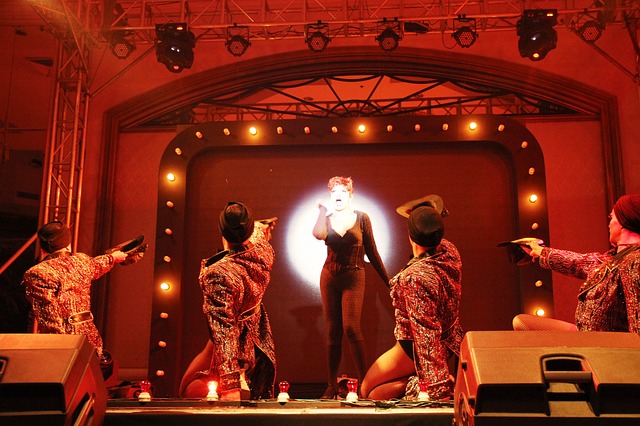Let’s not sugarcoat it: it isn’t easy to break into the musical theatre industry, and nobody is going to hand you a leading role in a Broadway show on a silver platter…
… but there’s more than one way to skin a cat.
Below you’ll find a breakdown of numerous professional jobs in musical theatre (along with their ballpark salary expectations, career paths and difficulty of attaining paid work). The good news is that many of them lead into one another, creating a multitude of routes into the musical theatre job you’re aiming for.
Some require prior training at musical theatre school while others rely more on on-the-job experience (and a little bit of hustle). Learn more as we explore:
Jobs in Musical Theatre: Work, Salaries & Career Paths
Front of House

We figured it would be sensible to start with front of house roles given that it’s often the starting block for many a good career in musical theatre. It’s often menial work – selling tickets or refreshments and/or showing people to their seats, for instance – but hey, it’s a start.
Front of House Career Path: See a job listing calling for front of house staff, prove you’re capable of serving patrons, and away you go.
Pros: In some cases, you get to see the show for free (or at least get discounted tickets.)
Cons: Doing the same thing, ad infinitum, often without pay.
Difficulty: 1/10
Front of House Salary: It depends on the theatre (and its location), but the hourly rate can vary from being totally voluntary to $15 or $20 at the top end. A front of house manager earns around $35,000 on salary.
Musical Director

A musical director generally works under the lead director and producer, and acts as a conduit between the upper management and everyone else. However, after the rehearsals are wrapped up and the show’s run begins, the director/producer tend to take a backseat. At this point, the musical director will work with the stage manager (see below) to keep the entire production on track thereafter.
Not to be confused with a theatre director, who runs the venue itself.
Musical Director Career Path: Many musical directors start of as musicians first and foremost such as violinists or pianists, working on small productions before being tasked with leadership roles. Attending musical theatre school can accelerate this, and needless to say music lessons in a chosen instrument (or many) is almost essential.
Pros: If you love mixing creativity with logistics, this is the job for you.
Cons: A lot of responsibility, not a lot of credit.
Difficulty: 8/10
Musical Director Salary: Between $40,000 and $60,000 dependent on experience and production level.
Stage Manager

A broad term to refer to the head honcho who ensures everything that under the remit of the musical director (above) runs smoothly. The checklist of duties can be huge depending on the production: blocking, cues, lighting, scenery, props, and scheduling and reporting to the director and producers are all part and parcel of the job.
Stage Manager Career Path: As with the musical director, a stage manager typically starts small and works up. A deep understanding of everyone’s role on the team is essential, which typically requires formal tuition at musical theatre school.
Pros: The job satisfaction is huge, given that you’re pretty much solely responsible for putting on a good show.
Cons: You don’t know the meaning of the word pressure until you try being a stage manager on a big production.
Difficulty: 9/10
Stage Manager Salary: Generally paid on a per-weekly basis of anywhere between $0 and $3000, depending on production size.
Producer
One of the most nebulous terms in both musical theatre and film, a producer can be expected to wear many hats during the course of a show’s run, but is primarily in charge of raising funds, managing said funds, and sometimes hiring personnel. The producer is usually the one to have discovered the script and initiated the production.
Producer Career Path: Business savvy is arguably more important than performance skills, but having an eye for this is also vital. Being rich helps a lot, too.
Pros: In a nutshell, the payoff can be huge (financially speaking)
Cons: You can also bankrupt yourself and/or your production company really, really easily.
Difficulty: 10/10
Producer Salary: No reliable averages exist given that earnings are almost always royalty based, so we’re talking about a range of millions to negative millions.
Theatrical Makeup Artist

As you can imagine, being a makeup artist for musical theatre is a slightly different discipline to makeup artistry for models, photoshoots, and other types of beautician work, since it often calls for quite dramatic results under the harshest of lighting conditions.
Theatrical Makeup Artist Career Path: Given the technical knowledge necessary, it’s rare for makeup artists to have no specialist training in this area (though not entirely unheard of). A strong portfolio is also mandatory.
Pros: A lot of opportunity to unleash your creative prowess and work with a varied group of performers.
Cons: The overheads can be quite pricey when you’re starting out and having to purchase a lot of materials on your own dime.
Difficulty: 7/10
Theatrical Makeup Artist Salary: The average hourly wage reported by the Bureau of Labor Statistics is pegged at $30, with a mean average annual of $58,000. Obviously, this is just a ballpark figure for those working freelance.
Choreographer

An essential role in bringing a musical theatre production to life, choreographers are responsible for a very important part of the show: working out exactly how the talent should move when on the stage (and that is usually more than just the dance routines). Like makeup artists, choreographers have been a part of the industry since the inception of theatre in Greek antiquity.
Choreographer Career Path: Formal tuition isn’t strictly necessary, but nearly all choreographers are trained dancers and go on to work either on a self-employed basis or via a dance company. Occasionally, the director doubles up as the lead choreographer on a production.
Pros: If dance is in your veins, there’s nothing better than being the person who creates the routines.
Cons: Expect outrageously long, 16 hours work days with a lot of traveling for work. Dance-related injuries are also common.
Difficulty: 6/10
Choreographer Salary: Averages around $50,000 per year, but with the caveat that earnings can go up or down depending on freelance work available (if not signed with a dance company.)
Dancers, Actors and Singers

Working directly under the choreographer, directors, and stage managers are the main event: the people who the public have paid good money to see. This more generic entry covers a wide swathe of skill sets and different disciplines, with some members being proficient in just one or many.
Career Path: Entirely depends on your chosen field. Naturally, a dancer should seek expert dance tuition and a singer should undergo vocal lessons in order to maximize the chances of being hired. For a well-rounded education in all of the major skills, attend musical theatre school.
Pros: The thrill of performing, of course!
Cons: It’s one of the most competitive fields in entertainment. You could be flying high one moment, then struggling to find work the next. Also, the work itself is a lot more grueling than a lot of people are prepared for.
Difficulty: 9/10
Talent Salary: Thanks to the Actor’s Equity Association, the minimum you should be paid is $1,754 per week if you’re on Broadway. If you’re off Broadway, this drops to $500 per week. The good news is it’s a growing industry with average wages rising with theatre profits.
Scenic Carpenter

As the title suggests, a scenic carpenter’s role is to create sets and structural elements of the production as requested by the production manager. Scenic carpenters typically don’t paint the set pieces themselves (which falls under the scenic artist’s remit), but may be required to also work on rigging in smaller productions which don’t have a budget for two separate professionals.
Scenic Carpenter Career Path: Simply put, proficiency in carpentry is required. Formal qualifications are usually requested given that poor structural work can endanger lives.
Pros: There’s a lot of job satisfaction to be had when you finally get to see the finished set, in action, that you helped create from the ground up.
Cons: Explaining for the hundredth time why that design might look good on paper, but it breaks numerous laws of physics in reality.
Difficulty: 6/10
Scenic Carpenter Salary: Nearly always paid on a freelance, hourly basis and not much better than other low-grade stagehands at $8-$10 per hour. This can go up to $20-$25 per hour if managing a team.
Costume Attendant
Very few musicals can operate without a team of wardrobe staff, and costume attendants make up the bulk of this workforce. Tasked with making sure costumes fit the stage talent, keeping them in good condition between shows, and helping actors in and out of them during the show, a costume attendant may also be responsible for choosing the costumes themselves. However, this is usually the duty of the wardrobe supervisor (whom costume attendants report to.)
Costume Attendant Career Path: There isn’t a strict route into gaining work in the costume department of a production, and many who do so came from different stagehand disciplines. Skill with couture is obviously a prerequisite, and formal fashion training can help you climb the career ladder quicker, but otherwise it’s all down to your portfolio.
Pros: Getting to work with pretty much the entire team, from fellow stagehands to the actors, right up to the director. It’s a great job for learning many facets of musical theatre.
Cons: Work can be sporadic at best, but on the days you are requested, expect long hours.
Difficulty: 5/10
Costume Attendant Salary: The hourly average as reported by the Bureau of Labor Statistics (specifically for theatre) is reported as $26.80, which is only a shade below the same role in motion pictures at $27.02.
Lighting Designer
Along with scenic carpenters and costume staff, lighting designers fall under the umbrella category of “theatrical technician.” Lighting designers work hand-in-hand with light board operators, the former planning everything out in advance to match the artistic vision of the show, while the latter makes sure that plan is followed on the night.
Lighting Designer Career Path: A highly technical profession, lighting designers either learn from a very basic level in an amateur theatre setting, or undertake full training in electronics or another related field. Working as an associate LD under a lead designer is a good way of cutting your teeth in the industry.
Pros: The skills you’ll learn are highly sellable, even when you’re not working the theatre circuit (think music concerts, photo shoots, etc.).
Cons: It’s an under-appreciated art form.
Difficulty: 7/10
Lighting Designer Salary: A healthy $50,000 per year on average, but that’s across the whole industry (not just theatre). Light board operators, on the other hand, earn substantially less; only around $10 per hour on a freelance rate, for a national average of $30,000 per year.
Develop your performance skills across singing, dancing, and acting disciplines with our 4-Week Musical Theatre Workshop with the support of a Broadway-level faculty. Visit our 4-Week Musical Theatre Workshop page to learn more.
